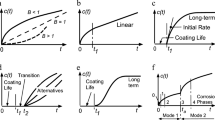Abstract
Corrosion testing has evolved to the point where it is possible to compare the relative corrosion resistance of two or more materials in a small number of experiments of relatively short duration. However, this comparison is only valid for the environments used for the experiments, and these experiments are frequently considered poor indicators of ctual in-service behavior. This paper examines the emerging need for better prediction of performance in corrosive environments, the form that a prediction should take, and some of the tools being developed and explored for meeting this need.
Similar content being viewed by others
References
G.G. Eldredge, Corrosion, 13 (1957), pp. 51.
E.J. Gumbel, Statistical Study of Extreme Values and Some Practical Applications, Applied Math Series 33 (Washington, D.C.: National Bureau of Standards, 1954).
P.M. Aziz, Corrosion, 12, (1956), pp. 495.
J. Galambos et al., Extreme Value Theory and Applications, vol. 1 (Boston, MA: Kluwer Academic Publishers, 1993).
J. Galambos et al., “Extreme Value Theory and Applications,” vol. 2, J. Res. of the National Inst. of Std. and Tech., 99(4) (1993), pp. 313–569.
J. Galambos et al., Extreme Value Theory and Applications, vol. 3, NIST Special Publication 866 (Gaithersburg, MD: National Institute of Standards and Technology, May 1993).
M. Kowaka, Introduction to Life Prediction of Industrial Materials (New York: Allerton Press, Inc., 1994).
C.P. Sturrock, “NACE-NIST Corrosion Data Program The First Ten Years,” Materials Performance, 32(11) (1993), pp. 13–19.
D. Silverman, private communication, Monsanto, St. Louis, MO, May, 1993.
R.W. Staehle, “Understanding Situation Dependent Strength: A Fundamental Objective in Assessing the History of Stress Corrosion Cracking,” Environment-Induced Cracking of Metals, ed. R.P. Gangloff and M.B. Ives (Houston, TX: National Association of Corrosion Engineers, 1990).
R.W. Staehle, “Environmental Definition” (Paper presented at Canadian Metallurgical Society Meeting, 1991).
R.W. Staehle, “Relationship Amoung Statistical Distributions, Accelerated Testing and Future Environments,” Application of Accelerated Corrosion Tests to Service Life Prediction of Materials, ed. G. Cragnolino and N. Sridhar (Philadelphia, PA: ASTM, 1992).
R.W. Staehle, “Combining Design and Corrosion for Predicting Life” (Paper presented at Life Prediction of Cor-rodible Structures, Kauai, Hawaii, 1991).
M. Pourbaix, Atlas of Electrochemical Equilibria in Aqueous Solutions (Houston, TX: National Association of Corrosion Engineers, 1974).
M.F. Ashby, “Materials in Mechanical Design,” MRS Bulletin, (7) (1993), pp. 43–53.
M.F. Ashby et al., “Fracture-Mechanism Maps and Their Construction for FCC Metals and Alloys,” Acta Metall., 27 (1979), pp. 699–729.
C. Gandhi and M.F. Ashby, “Fracture-Mechanism Maps for Materials which Cleave: FCC, BCC and HCP Metals and Ceramics,“ Acta Metall., 27(9) (1979), pp. 1565–1602.
R.E. Ricker et al., Hydrogen Embrittlement of Ductile Nickel Aluminide During Corrosion in Aqueous Solutions (Warrendale, PA: TMS, 1990).
U. Bertocci et al., “Passivity and Passivity Breakdown on Nickel Aluminide,” Corrosion Science, 31 (1990), pp. 471–478.
R.E. Ricker et al., “The Effect of Aqueous Environments on the Fracture Behavior of Nickel Aluminide,” Scripta Metall., et Mater., 24(2) (1990), pp. 291–296.
R.E. Ricker et al., “Evaluation of the Environmental Induced Fracture Resistance of Nickel Aluminide,” Environmental Effects on Advanced Materials, ed. R.H. Jones and R.E. Ricker (Warrendale, PA: TMS, 1991), pp. 213–225.
J.E. Wells, Probabilistic Design, Report to U.S. Atomic Energy Commission UCRL-51732 (Livermore, C A: Lawrence Livermore Laboratory, January 27,1975).
W. Mendenhall and T. Sincich, Statistics for Engineering and the Sciences (San Francisco: Dellen Publ. Co., 1992).
P.R. Bevington, Data Reduction and Error Analysis for the Physical Sciences (New York: McGraw-Hill, 1969).
Author information
Authors and Affiliations
Rights and permissions
About this article
Cite this article
Ricker, R.E. Can corrosion testing make the transition from comparison to prediction?. JOM 47, 32–35 (1995). https://doi.org/10.1007/BF03221252
Issue Date:
DOI: https://doi.org/10.1007/BF03221252




